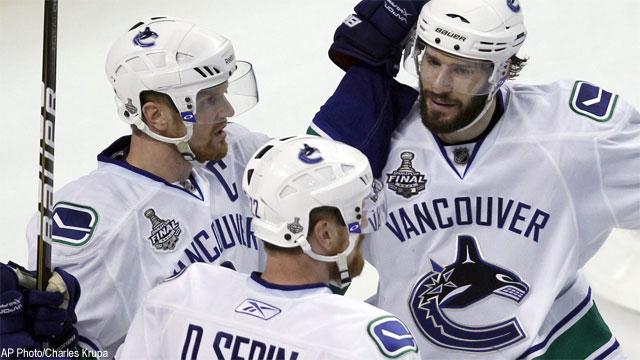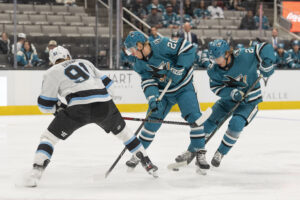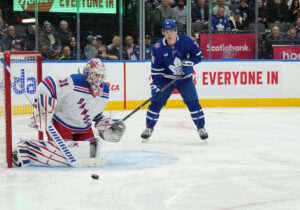Before Monday, there were five Vancouver Canucks in the Hall of Fame. Kind of.
An Increasing Number of Canucks in the Hall
Previously, the only unequivocal Vancouver Canuck in the Hall of Fame was Pavel Bure. Obviously, he deserves to be there. As awkward as his parting was, he spent well over half of his career in Vancouver. The only other player who you could justify calling a Canuck – if you squint hard enough – is Igor Larionov.
A Quick Aside
While it looks like the Canucks “gave up” on Larionov after three seasons, the reality was more complicated. The Russian hockey federation was being paid a large portion of money for any contract he signed with Vancouver – the team that got him out of the Soviet Union. They would continue to do so for as long as he continuously played for Vancouver. Larionov obviously hated that deal. So to “break” the continuity, he left for Switzerland. Not knowing when he’d return, the Canucks decided not to maintain his rights and he was scooped by the desperate San Jose Sharks.
Ryan Kesler joins #Canucks Central with @SatiarShah and @JamieDodd next to talk about his time with the Sedins and Luongo, plus what he’s up to now.
LISTEN: https://t.co/mDLZc4njsd pic.twitter.com/ISXAJx4f51
— Sportsnet 650 (@Sportsnet650) June 30, 2022
They shipped him to the Detroit Red Wings, where he played the majority of his NHL career and won his three Stanley Cups. “The Professor” may have started with Vancouver, and he was great there, but really? That’s not the skate jersey he’s wearing. Now back to your regularly scheduled program.
Who? Meets Them!
The other three inductees were Cam Neely – a constant, painful reminder of the risk of trading potential – Mats Sundin – did you remember that? – and Mark Messier, who many fans are desperate to forget ever played on the West Coast. Messier got an undoubtedly sarcastic third-place vote for the Lady Byng, for crying out loud. Two left psychic scars on the fans and one was a virtual non-entity outside being a one-year feel-good story. It’s not really a great track record for the team’s first half-century in the NHL.
That’s been course-corrected. There are now, legitimately, four Vancouver Canucks in the Hall of Fame. Er, kind of.
Hi, Hen- Uh, Dan- Uh…
Brian Burke isn’t the best general manager the league has seen, but there is one unquestioned coup in his history. It’s been repeated in many, many forms over the years – including by us – but if you want to hear it from the horse’s mouth? Try this recent interview.
There has been some pushback on whether the Sedins are worthy entrants. And you know what? That is a fair discussion – if the only determining factor is points. But it’s not. Yes, both Henrik Sedin and Daniel Sedin broke the 1,000-point barrier, and both have an Art Ross Trophy. But there are players with more points outside the Hall, though not many. There are players with longer careers outside the Hall. So why the Sedins?
Ray Ferraro had an excellent description of what makes a star in the NHL. If a team is coming to town, does the home coach draw up plans specifically because of them? And for the better part of a decade, teams knew perfectly well who was coming to town and couldn’t do a damn thing about it. Coming back from the 2004-05 lockout, the Sedin twins were rapidly becoming a nightmare for opponents.
Early Questions
They were sheltered behind the famous West Coast Express line of Markus Naslund – Brendan Morrison – Todd Bertuzzi until 2005-06. Come 2006-07, though, and the team went from being led by one of the best lines in the league to the duo act of Sedin and Sedin. They are a perfect example of how false the sentiment that “anyone can play with a star” is.
Their first three seasons were mostly played on a fourth line with the seasoned veteran Trent Klatt. It was a very gentle way to usher young players into the league on an improving team. Which is fine, but after three seasons fans were starting to grumble. These we the two of the top-three picks, after all. They were going to show more than the occasional flashes soon, right? No kidding, the flashes of talent – blind passes, extended cycle game, ridiculous feeds – were great! But… it’s been three years.
Breaking In
After Klatt came the Mattress Line – two twins and a king. Jason King‘s career had a solid start with the Sedins before a concussion derailed his NHL career. They were still in the bottom six but started producing, and King scored 12 times in his rookie season. He took over for an ineffective Magnus Arvedson, signed partly to play with the Sedins. They had good totals, given their ice time. Henrik finished with 42 points and Daniel with 54 while averaging 13:30-14:00 of ice time.
The big change came after a break – the lockout of 2004-05. Daniel and Henrik had always been students of the game, and they realized how hard they were going to have to work to resist the physical side. Teams knew if they could knock one off stride, their cycle game would be less effective. While they were never intimidated by players, early on they could be knocked down relatively easily. So they made sure that particular tactic would stop working.
By the time the newest Canucks in the Hall of Fame came back for 2005-06 until the end of their careers, they were legendarily fit. The Sedins took it upon themselves to lead the team on the intimidating Grouse Grind well into their 30s.
The Cycle Game
They returned, lined up with free-agent signing Anson Carter on the Three Brothers line. Carter was an excellent match, and the trio was soon forming a top-six with the West Coast Express. How well did they work together? Of Carter’s career-high 33 goals in 2005-06, 21 of them were assisted on by both Sedins. Henrik had 75 points that season, Daniel 71. The 32-year-old Carter was handed a bag of cash by the Columbus Blue Jackets and he walked the next year.
After that came a lot of looking. Taylor Pyatt, Steve Bernier, and Naslund were all given long tryouts with the Sedins. Naslund worked well enough with them, but it reduced the Canucks to a single-line team. Even the old veteran Trevor Linden had his time with the twins. Eventually, bizarrely, out of pure desperation coach Alain Vigneault went with the undrafted penalty-killing agitator Alexandre Burrows. That seemed to work out all right.
Burrows was a fixture on the Canucks top line until his departure in 2016-17. He killed penalties all the while, which the Sedins didn’t, so he was spelled off by Mikael Samuelsson, Ryan Kesler, or Jannik Hansen. Hansen would take up residence beside the Sedins when Burrows was traded. Appropriate, given his 9th-round selection. That was just the sort of player who worked best with them.
Where They Belong
In the end, the Sedins are absolutely worthy of being the next Vancouver Canucks in the Hall of Fame. The super-long “slap-pass” or long tip to the slot was theirs, and an absolutely deadly weapon. Passes off the boards, behind the back, on the cycle, and yes, they could control how the puck was spinning when it landed. If you were right-handed, they passed you the puck spinning clockwise. Left-handed, counter-clockwise.
This isn’t even including how much they meant off the ice. We don’t know whether board members take public work into account or not, but if the Hall of Fame is about a player’s impact? The two of them made a deep and lasting impression on the people of British Columbia.
Would they have gotten in if different teams had taken them in the 1999 draft? It seems unlikely. Does that matter? Not in the least. Some might say that there are three more Canucks in the Hall of Fame, but only two more entries. And if they want to say that, it’s fine. They went in together because of how they played together. And together is how they earned the call.






